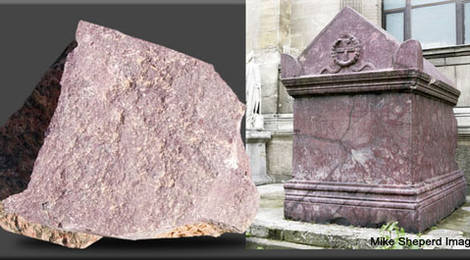
Porphyry – Imperial Stone of the Roman Empire
Porphyry is an igneous rock similar in composition to granite. Unlike common granites, pophyry has large, light-colored crystals of quartz or feldspar floating in a red or purple fine-grained matrix of smaller crystals. The word “porphyry” comes from the Latin word for purple, which was the color of nobility to the Romans. Porphyry was Imperial Rome’s most prestigious stone for columns, vases, alters, busts and other objects. Imperial porphyry had only one source, in one of the most inhospitable places on earth.
 Ancient Roman Quarry
Ancient Roman Quarry
In the year 18 AD, the Roman Legionaire Caius Cominius discovered a beautiful purple stone in the eastern desert of Egypt. It was a deep purple color with flecks of larger white crystals and was perfect for carving. This porphyry quickly became the most prestigious stone for the elite of Rome and Byzantium. For the next four centuries, the Romans (and their slaves) quarried this treasured stone at Mons Porphyrites (Porphyry Mountain) under appallingly difficult conditions in one of the harshest environments in the world.
 Long Way from Rome
Long Way from Rome
Although they are difficult locations, Mons Porphyrites, and nearby Mons Claudianus where a lighter-colored granite was also quarried, became an important source of stone for the empire. Because of the transportation required, columns and blocks were roughed out at the quarry to reduce weight. They were then ox-carted 150 km along the Via Porphyrites to the Nile at Qena. From there porphyry was shipped downstream by barge and eventually by ship throughout the Mediterranean. Abandoned by the Romans in the 5th century, Mons Porphyrites is still very remote and difficult to access.
 Imperial Stone
Imperial Stone
Stone from Mons Porphyrites can be found as panels in the Pantheon in Rome, as pillars in Baalbek’s Temple of Heliopolis in Lebanon, in the Hagia Sophia Cathedral in Turkey and in countless altars, statues, basins, and sarcocafagi throughout the ancient Roman empire.Although Mons Porphyrites provided the original porphyry and perhaps the most distinctively colored, it is no longer the only source. Porphyry deposits have been located on all continents.
 Modern Porphyry Quarries
Modern Porphyry Quarries
Porphyry is now quarried in many countries including Italy (near Trentino as shown at right), Argentina and Mexico. Porphyry is prized for its great compressive strength and exceptional durability. For this reason it is now most commonly used as a paving stone.
 Porphyry Paving Stones
Porphyry Paving Stones
Due to its exceptional durability, porphyry has been used for centuries as street paving in Europe. Porphyry paving stones are usually small squares or cubes as shown here; however, they are also available in larger paving stones. Sand-set porphyry is typically produced around three inches thick. Porphyry pavers that are to be set in mortar can be as thin as one inch thick.
